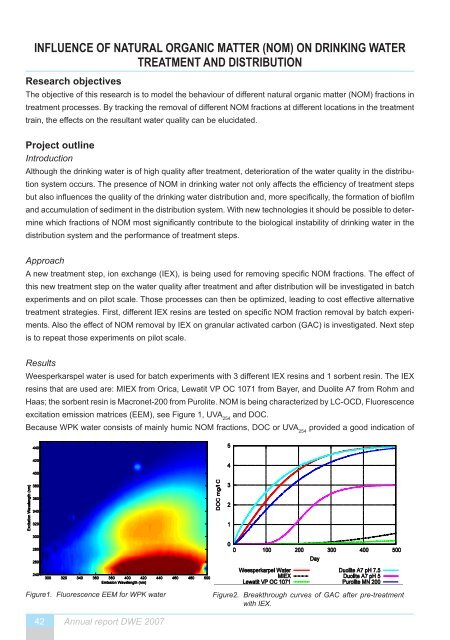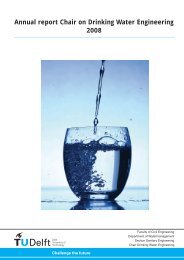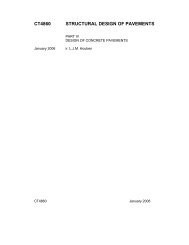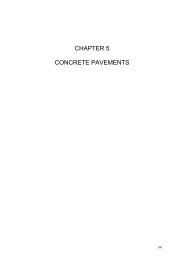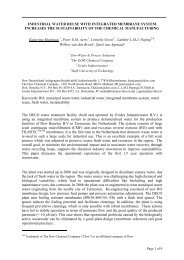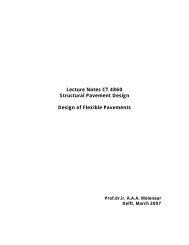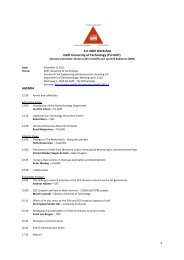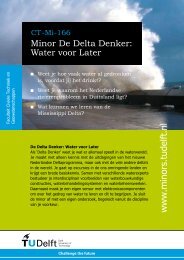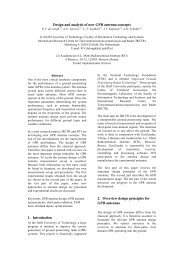Annual report Chair on Drinking Water Engineering 2007 - TU Delft
Annual report Chair on Drinking Water Engineering 2007 - TU Delft
Annual report Chair on Drinking Water Engineering 2007 - TU Delft
You also want an ePaper? Increase the reach of your titles
YUMPU automatically turns print PDFs into web optimized ePapers that Google loves.
INFLUENCE OF NA<strong>TU</strong>RAL ORGANIC MATTER (NOM) ON DRINKING WATER<br />
TREATMENT AND DISTRIBUTION<br />
Research objectives<br />
The objective of this research is to model the behaviour of different natural organic matter (NOM) fracti<strong>on</strong>s in<br />
treatment processes. By tracking the removal of different NOM fracti<strong>on</strong>s at different locati<strong>on</strong>s in the treatment<br />
train, the effects <strong>on</strong> the resultant water quality can be elucidated.<br />
Project outline<br />
Introducti<strong>on</strong><br />
Although the drinking water is of high quality after treatment, deteriorati<strong>on</strong> of the water quality in the distribu-<br />
������������������������������������������������������������������������������������������������������������<br />
�����������������������������������������������������������������������������������������������������������������<br />
and accumulati<strong>on</strong> of sediment in the distributi<strong>on</strong> system. With new technologies it should be possible to deter-<br />
����������������������������������������������������������������������������������������������������������������<br />
distributi<strong>on</strong> system and the performance of treatment steps.<br />
Approach<br />
����������������������������������������������������������������������������������������������������������<br />
this new treatment step <strong>on</strong> the water quality after treatment and after distributi<strong>on</strong> will be investigated in batch<br />
experiments and <strong>on</strong> pilot scale. Those processes can then be optimized, leading to cost effective alternative<br />
������������������������������������������������������������������������������������������������������������ments.<br />
Also the effect of NOM removal by IEX <strong>on</strong> granular activated carb<strong>on</strong> (GAC) is investigated. Next step<br />
is to repeat those experiments <strong>on</strong> pilot scale.<br />
Results<br />
Weesperkarspel water is used for batch experiments with 3 different IEX resins and 1 sorbent resin. The IEX<br />
resins that are used are: MIEX from Orica, Lewatit VP OC 1071 from Bayer, and Duolite A7 from Rohm and<br />
����������������������������������������������������������������������������������������������������������<br />
excitati<strong>on</strong> emissi<strong>on</strong> matrices (EEM), see Figure 1, UVA and DOC.<br />
254<br />
Because WPK water c<strong>on</strong>sists of mainly humic NOM fracti<strong>on</strong>s, DOC or UVA provided a good indicati<strong>on</strong> of<br />
254<br />
��������� ������������������������������<br />
42 <str<strong>on</strong>g>Annual</str<strong>on</strong>g> <str<strong>on</strong>g>report</str<strong>on</strong>g> DWE <strong>2007</strong><br />
Figure2. Breakthrough curves of GAC after pre-treatment<br />
���������


